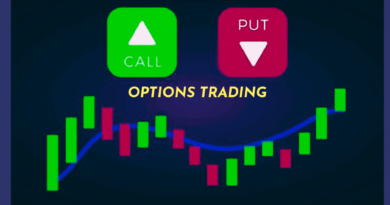Options Trading Safety Net: 7 Strategies for Intelligent Risk Management
Risk Management in Options Trading
Options trading offers both lucrative opportunities and potential risks. Skillful risk management is essential to safeguarding your capital while capitalizing on profit potential.
Let’s explore the risk management strategies and guidelines that can assist you in finding the right proportion of risk and return.
1. Understanding Risk and Reward
Risk: In options trading, risk refers to the potential loss that can occur from an unfavorable price movement. Risk is inherently linked to the premium you pay for the option. Unlike stocks, where losses can be unlimited, options trading’s defined risk comes from the premium paid.
Reward: Reward represents the potential profit from a favorable price movement. It’s essential to assess the potential reward against the risk taken before executing a trade.
2. Calculating and Utilizing Risk-Reward Ratios
The risk-reward ratio helps you assess whether a trade is worth pursuing. It’s the ratio of potential reward to potential risk. As a general rule, one should aim for a risk-reward ratio of at least 1:2, which means that the possible reward should be at least twice as great as the potential risk.
3. Position Sizing and Diversification
Position Sizing: It’s important to choose the right position size for every trade. Never risk more than a predefined percentage of your total capital on a single trade. This protects your capital from substantial losses in case of unfavorable outcomes.
Diversification: Spreading your capital across different trades and asset classes helps mitigate the impact of losses from any single trade. Diversification reduces the risk of significant drawdowns.
4. Risk Management Strategies
Stop-Loss Orders: Use stop-loss orders to automatically exit a trade if the option’s price moves against you. This reduces the possibility of losses and stops emotional decision-making.
Hedging: Employ hedging strategies to protect your existing positions against adverse price movements. For example, if you own stocks, buying put options can provide a hedge against potential price declines.
5. Using Trading Plans and Strategies
Create a well-defined trading plan that outlines your goals, risk tolerance, entry and exit strategies, and position sizing rules. Following a plan helps you make consistent decisions and minimizes impulsive actions driven by emotions.
6. Incorporating Technical and Fundamental Analysis
Utilize technical analysis tools to identify trends, support and resistance levels, and potential entry and exit points. Consider fundamental analysis to understand the underlying factors affecting the asset’s price. Earnings reports, economic data, and news events can impact option prices.
7. Monitoring and Adjusting Trades
Regularly monitor your open positions to assess their progress and evaluate whether market conditions are aligning with your expectations.
Be prepared to adjust or exit a trade if conditions change or if the trade is not performing as anticipated.
Risk Calculation with Examples
Calculating potential risk is a critical aspect of options trading, as it helps traders make informed decisions and manage their positions effectively. We will cover the following risk calculations:
A.Maximum Risk in Buying Options
B.Maximum Risk in Selling Options
C.Calculating Break-Even Points
Let’s use a hypothetical scenario involving Company ABC, where the stock is currently trading at $50 per share.
Scenario:
You’re considering trading options on Company ABC. The call option has a strike price of $55, and the put option has a strike price of $45. The premiums for both options are $3 each, and you decide to buy one contract of each.
1. Maximum Risk in Buying Options:
Scenario:
Call Option Premium: $3
Put Option Premium: $3
Contracts Bought: 1 of each
Maximum Risk = (Call Option Premium + Put Option Premium) * Number of Contracts
Given Data:
Call Option Premium = $3
Put Option Premium = $3
Number of Contracts = 1 of each
Calculation:
Maximum Risk = ($3 + $3) * 1 = $6
Interpretation:
When buying options, the maximum risk is the total premium paid for the options. In this scenario, you’ve bought one call option and one put option, with each having a premium of $3. Therefore, your maximum risk for this trade is $6.
2. Maximum Risk in Selling Options:
Scenario:
Call Option Premium: $3
Put Option Premium: $3
Contracts Sold: 1 of each
Maximum Risk = (Call Option Premium + Put Option Premium) * Number of Contracts
Given Data:
Call Option Premium = $3
Put Option Premium = $3
Number of Contracts = 1 of each
Calculation:
Maximum Risk = ($3 + $3) * 1 = $6
Interpretation:
When selling options, the maximum risk is not as straightforward as buying options. It’s important to note that selling options involve unlimited risk potential, as the price of the underlying asset can move significantly against your position. In this example, the maximum risk is still $6 (total premium received), but the actual loss can be much larger if the stock price moves significantly beyond the strike prices.
3. Calculating Break-Even Points:
Scenario:
Call Option Premium: $3
Put Option Premium: $3
Call Option Strike Price: $55
Put Option Strike Price: $45
Total Premium Paid/Received: $6 (for both options)
Calculations:
Break-Even for Call Option:
Break-Even Price = Call Option Strike Price + Call Option Premium
Break-Even Price = $55 + $3 = $58
Break-Even for Put Option:
Break-Even Price = Put Option Strike Price – Put Option Premium
Break-Even Price = $45 – $3 = $42
Interpretation:
For the call option, your break-even price is $58. This means the underlying stock needs to rise above $58 for your call option trade to be profitable.
For the put option, your break-even price is $42. This means the underlying stock needs to fall below $42 for your put option trade to be profitable.
Note:
Options trading involves complex strategies and varying degrees of risk. These calculations provide a basic understanding of risk and break-even points, but real-world scenarios can be more intricate.
The maximum risk in selling options is theoretically unlimited. Risk management strategies are crucial when selling options.
Always consider commissions, fees, and other transaction costs when calculating risk and potential profitability.
The examples provided are for illustrative purposes and do not guarantee specific outcomes. Options trading involves risk, and potential results can vary based on market conditions and individual decisions. It’s advisable to conduct thorough research and seek professional advice before making trading decisions.
How to Get Started – Options Trading?
Starting in the realm of option trading may be thrilling as well as intimidating. You can set yourself up for a profitable trading trip by adhering to a systematic technique and comprehending the essential steps. Let’s examine how to start trading options.
1. Educate Yourself
Learn the Basics: Understand the fundamentals of options trading, including call and put options, strike prices, expiration dates, and premium pricing.
Read and Research: Study reputable books, online resources, and articles that explain options trading concepts in depth. Before you start trading, equip yourself with knowledge.
2. Choose a Trading Platform
Select a Brokerage: Choose a brokerage platform that offers options trading services. Consider factors like commissions, platform usability, research tools, and educational resources.
Open an Account: Sign up for an account with your chosen brokerage platform. Ensure that the platform is user-friendly and suits your trading needs.
3. Understand Your Risk Tolerance
Assess Your Risk Appetite: Determine how much capital you’re willing to allocate to options trading. Remember that options trading involves risk, and you should only trade with money you can afford to lose.
Define Your Goals: Clarify your trading objectives. Are you aiming for short-term gains, income generation, or long-term portfolio growth? Your goals will influence your trading strategies.
4. Develop a Trading Plan
Set Parameters: Create a trading plan that outlines your risk tolerance, preferred strategies, and criteria for entering and exiting trades.
Practice Discipline: Adhere to your trading strategy and refrain from emotional impulses. Consistency and discipline are key to successful trading.
5. Choose Your Strategies
Start Simple: Begin with straightforward strategies like buying calls or puts. As you gain experience, you can explore more complex strategies.
Paper Trading: Consider paper trading (simulated trading without real money) to practice your strategies and refine your skills without risking capital.
6. Execute Your First Trades
Start Small: Begin with a small position size to minimize risk while you’re still learning the ropes.
Monitor Your Trades: Pay close attention to the open positions you have. Set up alerts to be notified of significant price movements or changes in market conditions.
7. Continue Learning and Improving
Stay Informed: Stay updated on market news, economic indicators, and company earnings reports that could impact your trades.
Learn from Mistakes: Every trade provides an opportunity for learning. Analyze your successes and losses to identify areas for improvement.
8. Be Patient and Persistent
Mastery Takes Time: Remember that becoming a proficient options trader takes time and practice. Don’t get discouraged by initial setbacks.
Stay Curious: Continue to educate yourself and stay curious about evolving market trends and strategies.
Common Mistakes to Avoid in Options Trading
Option trading presents lucrative opportunities, but it’s also fraught with risks. To maximize your chances of success, it’s crucial to be aware of potential pitfalls and avoid common mistakes. Let’s examine some of the most common mistakes to steer clear of in option trading.
1. Overtrading and Overleveraging
Mistake: Engaging in excessive trading or risking a significant portion of your capital on a single trade.
Impact: Overtrading can lead to increased transaction costs, emotional exhaustion, and higher exposure to losses.
2. Ignoring Market Trends and News Events
Mistake: Failing to stay informed about market trends, economic indicators, and news events that can impact the underlying asset.
Impact: Ignoring important information can result in unexpected market movements that negatively affect your trades.
3. Neglecting Volatility
Mistake: Not considering the implied volatility of options when making trading decisions.
Impact: Ignoring volatility can lead to mispriced options and unexpected losses, especially when trading strategies that involve time-sensitive events.
4. Neglecting Risk Management
Mistake: Not implementing proper risk management strategies, such as setting stop-loss orders or diversifying your portfolio.
Impact: Lack of risk management exposes you to potentially large losses that can severely impact your capital.
5. Failing to Have a Trading Plan
Mistake: Trading without a well-defined plan that outlines entry and exit strategies, risk tolerance, and position sizing.
Impact: A lack of a trading plan can lead to impulsive decisions and emotional trading, increasing the likelihood of losses.
6. Chasing High Returns without Understanding
Mistake: Pursuing high returns from complex strategies without fully understanding their mechanics.
Impact: Complex strategies can lead to significant losses if executed incorrectly or without a deep understanding of their potential outcomes.
7. Not Considering Time Decay
Mistake: Not factoring in the impact of time decay (theta) when holding options until expiration.
Impact: Failing to consider time decay can result in reduced option value as expiration approaches, eroding potential profits.
8. Neglecting Liquidity
Mistake: Trading options with low liquidity and wide bid-ask spreads.
Impact: Low liquidity can result in difficulty entering and exiting positions at desired prices, leading to higher transaction costs.
9. Lack of Continual Learning
Mistake: Assuming that initial knowledge is sufficient without ongoing learning and staying updated on market trends.
Impact: The options market is dynamic; not staying updated can lead to missed opportunities or misinformed decisions.
10. Letting Emotions Drive Decisions
Mistake: Making impulsive trading decisions based on emotions like fear, greed, or panic.
Impact: Emotional trading can result in poor decision-making and lead to substantial losses.



